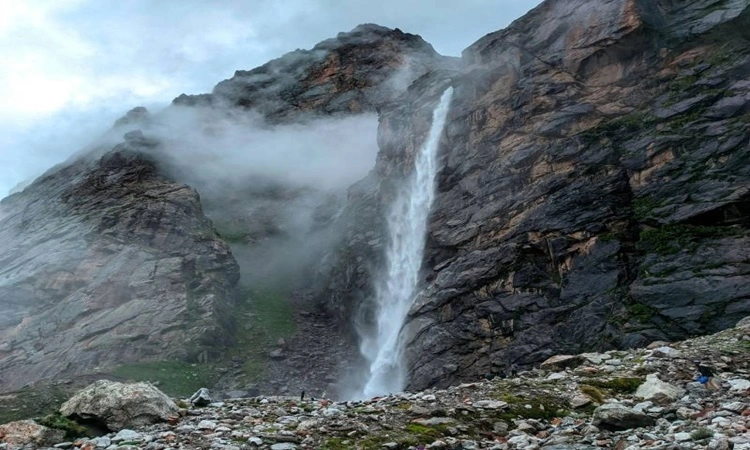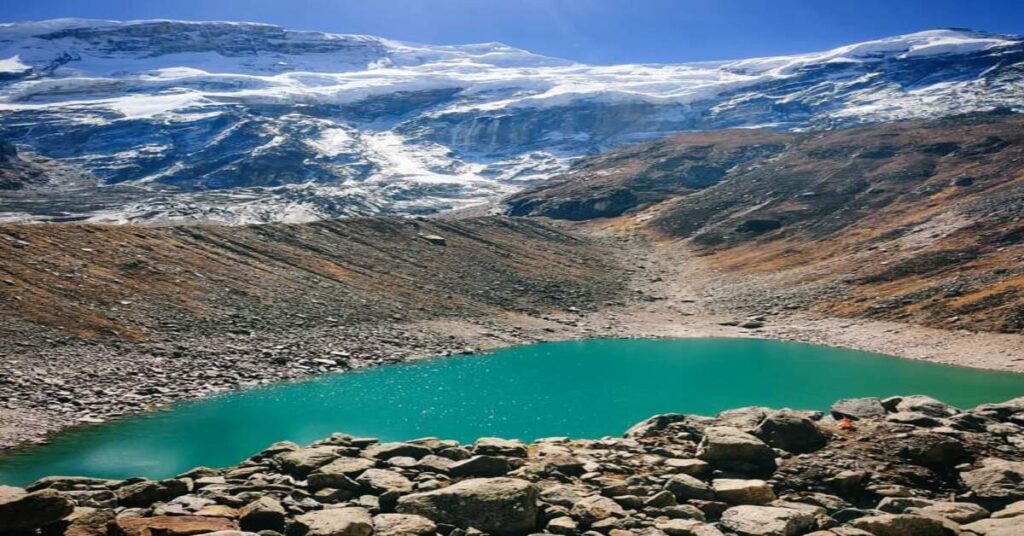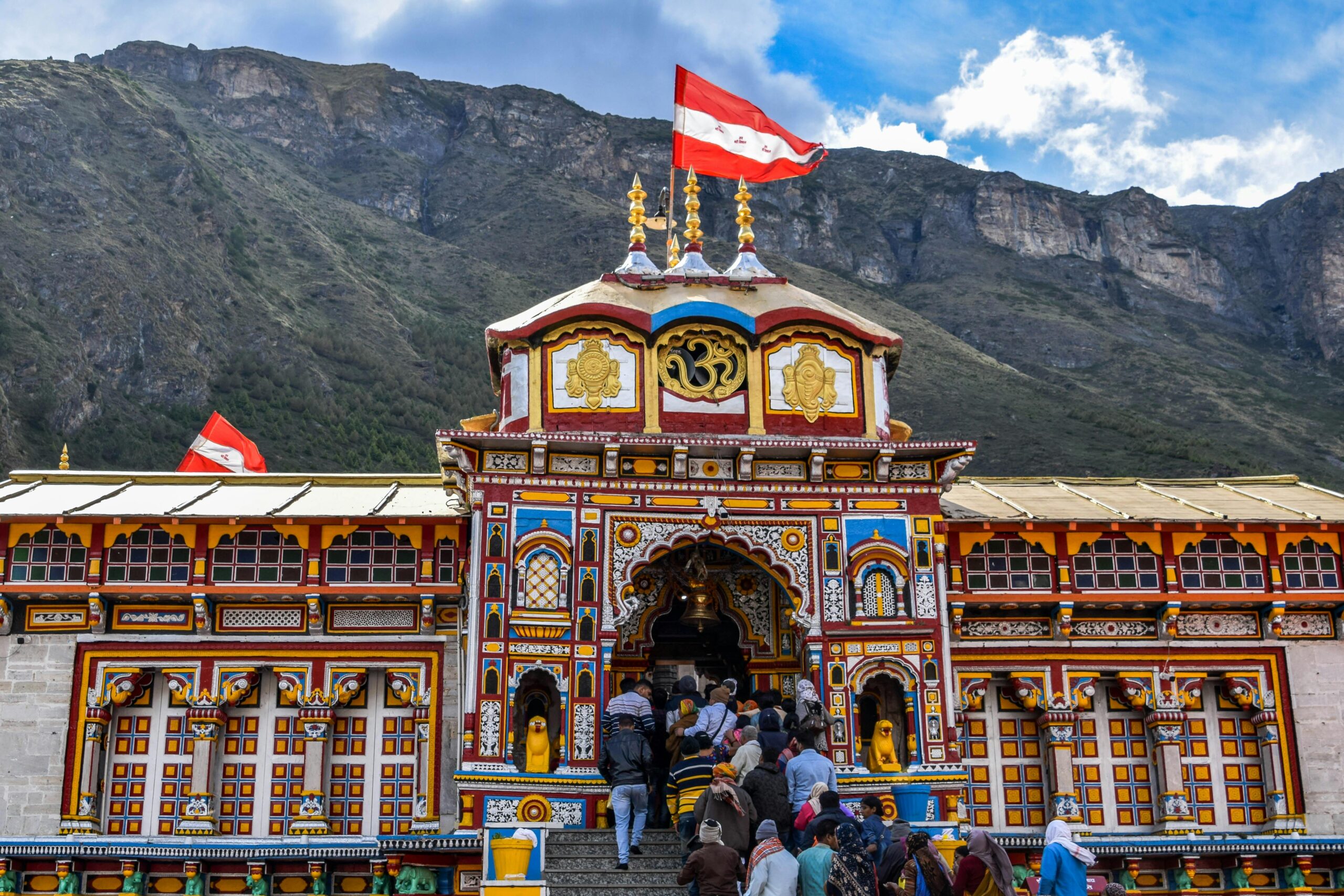Badrinath Temple, or Badrinarayan Temple, is a famous Hindu pilgrimage site. It is in the Chamoli district of Uttarakhand’s Garhwal Himalayas. It is positioned between the Nar and Narayana Mountain Ranges and is approximately 9 km east of Nilkantha Peak. The town is part of the Char Dham circuit, and it includes Kedarnath, Gangotri, and Yamunotri. Badrinath has a rich history connected to Hindu mythology. Many believe that Lord Vishnu, the universe’s protector, meditated here for years under the Badri Tree. His wife, Goddess Lakshmi, took the form of the Badri tree to protect him from the harsh weather. This is why the place is called Badrikashram or Badrinath, symbolizing a divine abode in the Himalayan wilderness.
In the 8th century, the great saint Adi Shankaracharya revived a temple. He sensed a supernatural call to find the idol of Lord Badri Narayan. While on a pilgrimage to Badrinath, he found a sacred place called Nara Kund or Narayan Kund near the southern bank of the Alaknanda River.
Adi Shankaracharya dove into the water of Narakund three times. The first two idols he found lacked identifying heavenly qualities, so he returned them to the river. On his third dive, he discovered a sacred idol. As he was going to return it to the water, a divine voice stopped him and said, “I am Badrinath, once consecrated by lord Brahma.” Give me my rightful place. Adi Shankaracharya established the customs that are still followed today according to his guidelines.
In the 19th century, the King of Jaipur renovated the temple. He wanted to protect it from the harsh Himalayan climate while keeping its beauty and functionality. Today, Badrinath is a part of the Chardham circuit along with the Chota Chardham of Uttarakhand. Because of the heavy snowfall in winter, it is open for 6 months (April to November), close of the year.
Make sure to complete your Char Dham Yatra Registration before planning your trip.

A journey through myth, nature, and divine bliss: Exploring Mana Village and beyond.
Mana village, a place which is 3 to 4 km away from Badrinath, is also known as the last Indian village near the Indo-China border– a place rich in history, mythology, and natural wonders. You can pre-book safe and budget-friendly GMVN guesthouses here for your stay at Badrinath or nearby areas. They’re government-run and reliable. Let’s go deep into this journey that is full of secrets about the Mahabharat, Himalayan herbs, and divine beauty!

A village where stories begin!
Mana is just not a village- it’s the beginning of an extraordinary adventure. The first thing you will notice is the pure air with the fragrance of wildflowers and medicinal herbs. Locals speak of rare Jadi buties (medicinal herbs) that grow in the surrounding forests. They say the herbs were used by the Maharishi and the Pandavas. They used them to treat bones and regain strength on a tough journey to Swarg Rohini. From bhringraj for vitality to ashtavarga– a rare combination of herbs.
But what makes this village truly magical? The place is rich in mythology. Locals say the village was a resting spot for Maharishi Vyas and the Pandavas. People say that this is the spot where Lord Ganesh began to write the Mahabharata after following Maharishi Vyas’s request. On day 1, you can spend a night here and explore medicinal herbs, traits and the mandir.
Ganesh Mandir: The Temple of Divine Beginnings
The journey leads us to Ganesh Mandir, devoted to Lord Ganesh. This temple is the location where the Mahabharata was written! The temple is beautifully covered with wooden doors and stone idols that have stood there for a long time.
Next to Ganesh Mandir, there is another temple of Saraswati Devi, the goddess of wisdom and knowledge. As the river flows fiercely, it becomes clear why the goddess is associated with knowledge, and the river itself represents the continuous flow of divine wisdom. On day 2, you can camp near the Saraswati River to feel divine energy.
If you’re planning to participate in special rituals or aartis, you can book poojas or darshan slots at Badrinath online in advance.

Bheem Pull: the bridge of legends
A short trek from the temples takes you to the Bheem Pull, a natural stone bridge that spans the Saraswati River. It is said that during the Pandavas’ journey to SwargRohini, Draupadi could not cross this river.
Guess who came to rescue her? Bheem, of course! With his strength, he lifts a massive stone across the river to create a bridge for her to cross. You can hear the echoes of their footsteps when you stand on this bridge today.
But do you know? The Saraswati River has its mystic charm. People call it the vanishing river, and they believe that it disappears underground after flowing past the Bheem Pull. Some say it merges with the Alaknanda River, while others claim that it remerges at Triveni Sangam in Allahabad. Some even say it goes to Patal Lok, but these are never-ending stories. The real reason is that the Saraswati river became extinct due to lord Ganesha’s curse, and nobody knows where it goes!
For any last-minute travel alerts, check the official Uttarakhand Tourism website — it provides live updates on weather and road conditions.

The Waterfall of Truth: A Natural Wonder
As you move further, you will see a hidden gem– the waterfall of truth. It is crystal clear water falling down from a great height, appearing like a liquid silver in the sunlight. But the interesting part is that the water of this spring does not touch the bodies of sinners. It is said that if the holy water starts falling on you, then you are a pure and virtuous soul. This spring has a nectar-like flavour because it is enriched with ayurvedic herbs. When the Pandavas passed through this fall, Sahadeva gave up his life near Vasudhara Falls. On day 3, you can trek from bheem Pull to the Vasudhara Falls to experience the place of spiritual cleansing.

Satopanth: the sacred Triangular Lake
As you climb higher, the scenery brings you to Satopant Tal, a triangular lake at a high altitude and surrounded by snow-covered mountains. The name ‘satopant’ means “path of truth,” and this Lake holds sacred significance for Hindus. It is said that the three corners of the lake symbolise Brahma, Vishnu, and Mahesh (Shiva). It is believed that the gods come here to bathe and meditate during Ekadashi or during special Times.
This place has special herbs, like Shilajit and kutki. The Pandavas used them on their journey.

On day 4, you can trek from the Falls to Satopanth Lake and spend a night at this peaceful location. If you love to stargaze, this location will be perfect for you!
The final ascent: Swargrohini and the Pandavas’ journey to heaven
The final part of this long journey is called Swarg Rohini, also known as the “stairway to heaven”. The journey to the point is difficult but breathtaking because of its beauty. According to the Mahabharata, it was this route, the Pandavas made their last journey.
But here is the heartbreaking twist! One by one, brothers fell because they could not overcome their human flaws. Draupadi first, then Sahadev, Nakul, Arjun, and lastly Bheem. However, yudhishthir alone continued along with a faithful dog called Dharma to reach the summit. And guess what? He said to have entered heaven alive! On day 5, you can trek from the lake to swargarohini and visit the spot where yudhidthir went to heaven. You can spend a few moments there before returning to Satopanth Lake or Mana Village.
Planning a visit to Kedarnath as well? You can book government-authorized helicopter rides through IRCTC to save time and avoid long treks.

The complete trek is 17 kilometers from Mana Village to Swargrohini. And takes around 5-6 Days, which are filled with breathtaking views, ancient stories, and moments of reflection.
A journey through time and nature
The journey from Mana village to Swarg Rohini is captivating, with a twist at every step. As you walk through this pass, you will immerse yourself in the magic of the Mahabharata, experiencing the touch of rare herbs that are costly in the market and the breathtaking beauty of the Himalayas.
Are you ready to start this once-in-a-lifetime adventure? Pack your bags, lace up your boots, and prepare to experience the journey that bridges the past and the present, myth and reality, and of course, heaven and earth.

FAQs
1. What is the best time to visit Badrinath Temple and Mana Village?
The best time to visit Badrinath and Mana Village is between May and October, when the temple is open and the weather is pleasant. Snowfall blocks the route in winter, so plan accordingly.
Check Char Dham Yatra opening dates here
2. How do I register for the Char Dham Yatra before visiting Badrinath?
All pilgrims must register for the Char Dham Yatra before their trip. Registration is mandatory and can be done online through the Uttarakhand Government Portal.
Register for Char Dham Yatra 2025
3. Can I book budget stays or government guesthouses in Badrinath or Mana Village?
Yes! The GMVN Guest Houses offer safe and budget-friendly accommodations in Badrinath and nearby areas like Mana. Pre-booking is recommended during peak pilgrimage season.
Book GMVN guest houses online
4. How long is the trek from Mana Village to Swargarohini, and what should I carry?
The trek from Mana to Swarg Rohini is around 17 km and takes 5 to 6 days. Carry trekking shoes, dry food, medicines, raincoats, and altitude sickness pills. Hire a local guide for safety.
5. What are some rare Himalayan herbs found near Mana Village and Satopanth?
The region is renowned for its medicinal herbs, including Ashtavarga, Bhringraj, Kutki, and Shilajit. Locals believe these herbs were used by the Pandavas during their final journey to heaven.

Leave a Reply